Create the Spot
You can first create the spot.
Click Spot
 in the Fastener Creation toolbar.
in the Fastener Creation toolbar.
Select the Fastener Set in the specification tree, if
needed.
The Spot Fastener Definition dialog box opens.
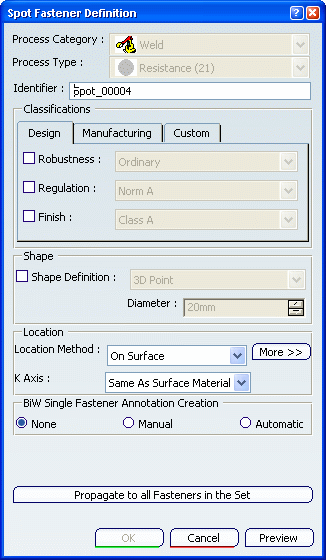
Optional: Modify the
Identifier set by default. Optional:
Modify the design parameters in the Design
tab. Optional: Modify the Manufacturing
parameters in the Manufacturing tab. Optional: Modify the customizable
parameters in the Custom tab. Optional:
Modify the Shape Definition.
Select the location method,
for instance:
Define the orientation of the
spot by setting the K Axis to either:
Choose whether you want to create a
fastener annotation or not.
Click the Propagate to all
Fasteners in the Set button so that all the overloaded classifications
and shape properties of this spot fastener are propagated to its parent
fastener set then to all fasteners contained in the fastener set.
Note that a warning dialog box is prompted: click Yes to
achieve the propagation and preview the modification in the 3D area
(the Propagate to all Fasteners in the Set button becomes
grayed out) or No to cancel the operation (the Propagate
to all Fasteners in the Set button stays available).
Click OK to create the spot.
The spot is added to the specification tree under the
Spot Fastener Set node.

Locate the Spot
You can use various methods to locate the spot.
Explicit
You can use the Explicit method.
Select a surface or a point where the spot is
to be created.
Optional: Click
More>> to display the Explicit dialog
box:
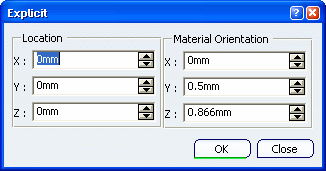
You can:
- modify the spot location by defining new coordinates,
- modify the material orientation if the reference point
do not lie on the surface.
Click OK to validate the changes.
On Point
You can use the On Point method.
Select a point.
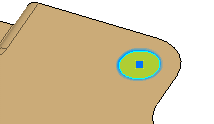
Optional:
Click More>> to display the On Point dialog
box:
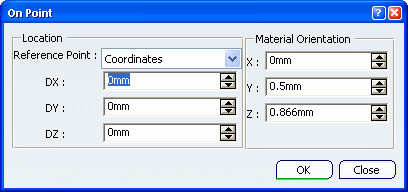
You can:
- modify the Reference Point type (selected
point, coordinates or axis origin),
- modify the material orientation if the reference point
do not lie on the surface.
Click OK to validate the changes.
On Surface
You can use the On Surface method.
Select a surface or a point to indicate the spot location.
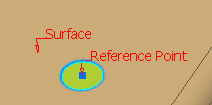
Optional: Click
More>> to display the On Surface dialog
box:
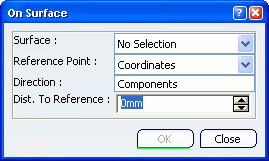
You can:
- modify the selected Surface,
- modify the Reference Point (selected point,
surface middle or coordinates),
- modify the Direction,
- modify the distance to the reference point (Dist.
To Reference).
Click OK to validate the changes.
On Curve
You can use the On Curve method.
The On Curve dialog box is automatically displayed:
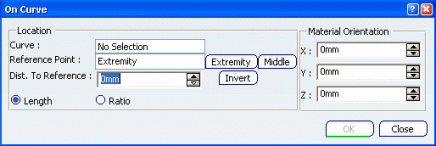
Select a Curve.
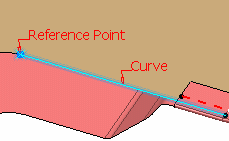
Optional: Select the Reference
Point (Extremity or Middle of the
curve). Optional: Modify the distance to the
reference point (Dist. To Reference). You can click
Invert to reverse the distance direction from the
reference point. Optional: Define the distance type (Length
or Ratio). Optional: Modify the material orientation
if the reference point does not lie on the surface. Click OK to validate the changes.
Point On Parallel Curve On Surface
You can use the Point On Parallel Curve On Surface method.
The Point On Parallel Curve On Surface dialog box
is automatically displayed:
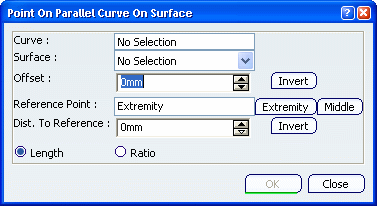
Select a Curve lying on a surface. Optional: Select a Surface.
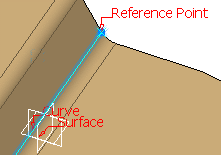
Optional: Modify the Offset
value. Optional: Modify the Reference
Point (Extremity or Middle of the
curve). Optional: Modify the distance to the
reference point (Dist. To Reference). You can click
Invert to reverse the distance direction from the
reference point. Optional: Define the distance type (Length
or Ratio). Click OK to validate the changes.
Intersect
You can use the Intersect method.
Select the first and the second element. Elements can either be two curves or a curve
and a surface.

Click
More>> to display the Intersect dialog
box:
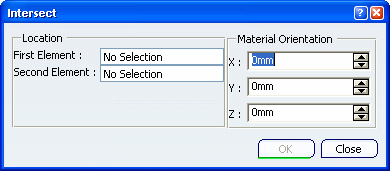
You can:
- modify the selected elements,
- modify the material orientation if the reference elements
do not lie on a surface.
Bitangent Circle Center
You can use the Buitangent Circle Center method.
The Bitangent Circle Center dialog box is automatically
displayed:
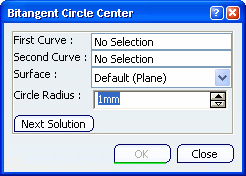
Select
the First Curve and the Second Curve.
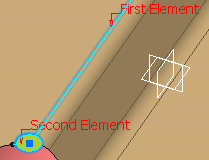
The resulting bitangent circle, highlighted in the 3D area,
is automatically computed and the default spot location is the
circle center. Optional: Select a support Surface
in the drop-down list or in the 3D area if the curves are not
coplanar. In this case, the center of gravity of the circle
is automatically computed. Optional: Define the Circle Radius
value.
Click
OK to validate the changes.

Create Spot Fasteners Annotations Automatically
You can automatically create a single fastener annotation during
the spot fastener creation or edition.

Specify
the type of annotation by activating one of the following options:
-
None: no annotation is created.
This option is set by default.
-
Manual: when clicking OK in the
Spot Fastener Definition dialog box, the annotation
command is automatically launched to let you set the annotation
parameters needed to create the annotation.
-
Automatic: a single fastener annotation associated
to the created fastener is automatically created after clicking
OK in the Spot Fastener Definition
dialog box.
Each field of the created annotation is automatically set
from:
-
the user preference file; i.e. BiW
Fastener Annotation parameters will be set from the
customization of the last created BiW Fastener Annotation.
For example, if Field 1of the previous created
BiW Fastener Annotation was set to ID-Process Type,
then Field 1 of the BiW Fastener Annotation
automatically created will display ID-Process Type
of the associated fastener.
-
if no user preference file already
exists (i.e. no previously created annotation), the
default BiW Fastener Annotation customization specified
in the Fst_Standard File for the Field Fi
is used, where i=1,..., 4.
For example, the default parameter set to Field
F1 for a BiW Fastener Annotation through the Fst_Standard
File is JEID (specified between <>)
or the first specified parameter.

For more information on customizing the Fst_STD Standard
File, refer to
Customizing the BiW Fastening Application Standard File.
Click OK to generate the annotation
associated to the created spot.
Using the Repeat Mode
You can use the repeat mode to create annotations.
If the Repeat object after OK option, (which is
available only with the On Curve and the Point
on Parallel Curve On Surface options) is selected during
the creation of fastener annotations:
- in case of an Automatic creation: repeated fasteners
and their BiW annotations are automatically created after clicking
OK in the BiW Fastener Repetition dialog
box.
- in case of Manual creation: the Welding
creation dialog box is displayed for the reference spot
fastener, then the BiW Fastener Repetition dialog
box to create the spot fasteners.
- the annotations of the repeated fasteners are further created
with the same parameters as that of the reference annotation
(that is the annotation associated to the reference spot fastener)
Using the Datum Mode
You can use the datum mode to create annotations.
Depending on the selection of the Create Datum
 icon in the Fastener Tools toolbar, the annotation will
be created in different ways.
icon in the Fastener Tools toolbar, the annotation will
be created in different ways.
- In case of an Automatic creation:
- If the icon is not activated during the automatic annotation
creation, the created annotation remains associative to
its fastener.
- If the icon is activated by a single click (i.e. not
permanent datum mode), then only the fastener is isolated
and the annotation remains associative to its fastener.
- If the datum mode is activated by a double-click (permanent
datum mode), then the fastener and its associated annotation
are isolated and the annotation is no longer associative
to its fastener. Therefore, modifying the fastener location
or fastener parameters has no impact on the datum annotation.
- In case of a Manual creation: the annotation
is created as a datum annotation whatever the activation of
the datum mode (simple or double-click).
|
![]()

![]()
![]()
![]() icon in the Fastener Tools toolbar, the annotation will
be created in different ways.
icon in the Fastener Tools toolbar, the annotation will
be created in different ways.














